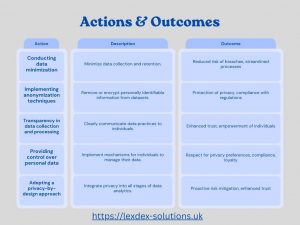When data is hailed as the new oil, businesses are increasingly recognising the critical importance of not just harnessing data but doing so responsibly. In the United Kingdom, privacy regulations such as the GDPR (General Data Protection Regulation) and the Data Protection Act set strict guidelines for the collection, storage, and processing of personal data. Adhering to these regulations isn’t just about compliance; it’s about fostering trust and safeguarding the fundamental rights of individuals, building Privacy-Respecting Data Analytics.
Data Minimization: Less is More
At the heart of privacy-respecting data analytics lies the principle of data minimization. Instead of collecting vast amounts of data indiscriminately, focus on gathering only what is necessary for your specific analytics objectives. This not only reduces privacy risks but also streamlines your data processes, making them more efficient and cost-effective.
Anonymization: Protecting Privacy Without Compromising Utility
One effective technique for achieving privacy-respecting analytics is anonymization. By removing or encrypting personally identifiable information (PII) from datasets, you can perform analyses without compromising individual privacy. However, it’s crucial to ensure that anonymization techniques are robust enough to prevent re-identification, which could potentially violate privacy laws.
Pseudonymization: Balancing Privacy and Utility
Pseudonymization is another valuable approach. Unlike anonymization, which renders data completely anonymous, pseudonymization replaces identifiable information with pseudonyms or aliases. This allows for analysis while still protecting individual privacy. However, it’s important to note that pseudonymized data is still considered personal data under GDPR and must be handled accordingly.
Privacy by Design: Building Privacy into Your Processes
Implementing a privacy-by-design approach is essential. By integrating privacy considerations into every stage of the data analytics process, from planning to execution, businesses can proactively address privacy concerns and mitigate risks. This includes conducting thorough privacy impact assessments and implementing appropriate technical and organizational measures to protect data.
Privacy-Enhancing Technologies: Innovations for Confidentiality
Embracing privacy-enhancing technologies (PETs) can significantly bolster your data analytics capabilities while preserving privacy. Techniques such as homomorphic encryption, secure multi-party computation, and differential privacy enable analyses to be performed on encrypted or obfuscated data, ensuring that sensitive information remains confidential.
Transparency and Control: Empowering Individuals
Transparency is key to building trust with consumers. Clearly communicate your data collection and processing practices, including the purposes for which data is being used and any third parties involved. Providing individuals with meaningful control over their data, such as opt-in/opt-out mechanisms and granular consent options, empowers them to make informed choices about their privacy.

Conclusion: Prioritizing Privacy for Long-Term Success
Data anonymization and pseudonymization should not be viewed as mere compliance exercises but as ethical imperatives. By prioritizing privacy in your data analytics initiatives, you demonstrate your commitment to respecting the rights and dignity of individuals. This not only strengthens your reputation as a trustworthy steward of data but also positions your business for long-term success in an increasingly privacy-conscious world.



